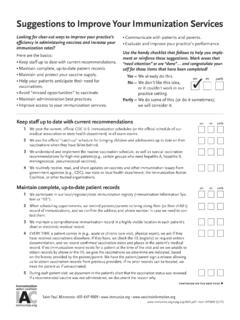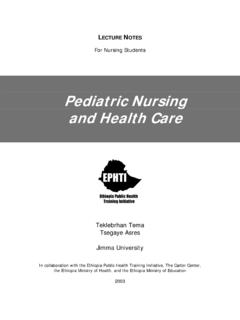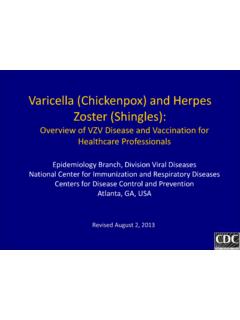Transcription of The Economic Impact of Pandemic Influenza in the United ...
1 659 Vol. 5, No. 5, September October 1999 Emerging Infectious DiseasesResearchInfluenza pandemics have occurred forcenturies, three times (1918, 1957, and 1968) inthe 20th century alone. Another Pandemic ishighly likely, if not inevitable (1). In the 1918influenza Pandemic , more than 20 million peopledied (2). Improvements in medical care andtechnology since the last Pandemic may reducethe Impact of the next. When planning for thenext Pandemic , however, decision makers needto examine the following questions: Would itmake Economic sense to vaccinate the entire if 15% were to become clinically ill?What if 25% were to become ill? To answer suchquestions, we conducted Economic analyses ofpotential intervention many studies have examined orreviewed the economics of Influenza vaccination(3-10), only one study (11), published in 1976,examined the economics of a vaccine-basedintervention aimed at reducing the Impact of aninfluenza epidemic in the United States.
2 Ourstudy examines the possible Economic effects ofthe next Influenza Pandemic in the UnitedStates, analyzes these effects, and uses theresults to estimate the costs, benefits, and policyimplications of several possible vaccine-basedinterventions. These estimates can be used indeveloping national and state plans to respond toan Influenza Unlike the 1976 study,ours examined the effect of varying the values ofa number of key input variables. Specificobjectives were to provide a range of estimatesregarding the number of deaths, hospitaliza-tions, outpatient visits, and those ill persons notseeking medical care in the next influenzapandemic; provide a cost estimate of healthoutcomes; estimate the potential net value ofpossible vaccination strategies;2 evaluate theeffect of using different criteria ( , death rates , Economic returns due to vaccination) to setvaccination priorities; assess the economicimpact of administering various doses of vaccineThe Economic Impact of PandemicInfluenza in the United States:Priorities for InterventionMartin I.
3 Meltzer, Nancy J. Cox, and Keiji FukudaCenters for Disease Control and Prevention, Atlanta, Georgia, USAA ddress for correspondence: Martin Meltzer, National Centerfor Infectious Diseases, Centers for Disease Control andPrevention, Clifton Road, Mail Stop C12, Atlanta, GA 30333,USA; fax: 404-639-3039; e-mail: estimated the possible effects of the next Influenza Pandemic in the UnitedStates and analyzed the Economic Impact of vaccine-based interventions. Using deathrates, hospitalization data, and outpatient visits, we estimated 89,000 to 207,000deaths; 314,000 to 734,000 hospitalizations; 18 to 42 million outpatient visits; and 20 to47 million additional illnesses. Patients at high risk (15% of the population) wouldaccount for approximately 84% of all deaths.
4 The estimated Economic Impact would beUS$ to $ billion, excluding disruptions to commerce and society. At $21 pervaccinee, we project a net savings to society if persons in all age groups are $62 per vaccinee and at gross attack rates of 25%, we project net losses if personsnot at high risk for complications are vaccinated. Vaccinating 60% of the populationwould generate the highest Economic returns but may not be possible within the timerequired for vaccine effectiveness, especially if two doses of vaccine are complete plan detailing a response to an Influenza Pandemic should include definition of a Pandemic , points that will initiatevarious steps in the response plan, and details about deploying the intervention. While a federal Influenza Pandemic planis being developed, a guide to aid state and territorial health officials in developing plans for their jurisdictions is available Printed copies can be obtained from the limited our examination of possible interventions to those involving Influenza vaccines.
5 We did not consider the use ofantiviral drugs for Influenza prophylaxis because there may not be adequate supplies; first priority for such drugs may be fortreatment; and the side-effects from the drugs, particularly amantadine, make them unsuitable for long-term prophylaxis formany workers, such as drivers, or heavy construction Infectious DiseasesVol. 5, No. 5, September October 1999 Researchand of administering vaccine to different agegroups and groups at risk; and calculate aninsurance premium that could reasonably bespent each year for planning, preparedness, ModelBuilding a mathematical model of the spreadof Influenza is difficult largely because ofdifferences in virus transmission and virulence,lack of understanding of the primary factorsaffecting the spread of Influenza , and shortage ofpopulation-based data (12).
6 Because of thedifficulties in calculating realistic estimates ofthe numbers of cases in the next influenzapandemic, we used a Monte Carlo mathematicalsimulation model (13-15), which uses predefinedprobability distributions of key input variables tocalculate the number of illnesses and deaths thatcould result from an Influenza Pandemic . Someof the most important probability distributionswe used describe the population-based rates ofillness and death. These rates are based onillness and death rates reported in earlierinfluenza pandemics and epidemics. The modelproduces a range of estimated effects rather thana single point estimate. The model is notepidemiologic and thus does not describe thespread of the disease through a details of the model are presentedbelow and in Appendix I; a more detailedexplanation and a complete list of all thevariables used and the values assigned to thevariables are available at Appendix interventions to contain and reduce theimpact of an Influenza Pandemic , we used asocietal perspective, which takes into account allbenefits and all costs regardless of who receivesand who Distribution and Persons at High RiskSince the age distribution of patients in thenext Pandemic is unknown, we assumed adistribution (Table 1) among the three agegroups (0 to 19 years, 20 to 64 years, and 65 yearsand older).
7 3 Further, each age group was dividedinto those at high risk (persons with apreexisting medical condition making them moresusceptible to complications from Influenza ) andthose not at high risk (Table 1).4 Age by itself wasnot considered a risk factor; persons 65 years andolder were assumed to have higher rates ofillness and death than the rest of the population(Table 2).3 This article presents the results for one distribution of cases by age and risk group. The background paper in Appendix II,however, contains additional results obtained by using a different Advisory Committee on Immunization Practices estimates that 27 to 31 million people ages <65 years are at high risk forinfluenza-associated complications (17). ACIP also classifies all 32 million people >65 years as being at elevated risk forinfluenza-related complications (17).
8 Further, the working group on Influenza Pandemic preparedness and emergency responsehas assumed that approximately 19 million household members of persons at high risk should also be vaccinated to reduce theprobability of transmission to those at high risk (GrIPPE, unpub. data, 1997).Table 1. Estimate of age distribution of cases andpercentage of population at high risk used to examinethe Impact of Pandemic Influenza in the United StatesAge group (yrs) Percentage of all casesa 0-19 20-64 65 + at high riskc 0-19 65 + actual number of cases will depend upon the assumedgross attack rate. The distribution of cases was based onlower and upper estimates of age-specific attack rates fromthe 1918, 1928-29, and 1957 epidemics and pandemics (19).
9 BTotals do not add to exactly 100% because of are categorized at high risk if they have apreexisting medical condition that makes them moresusceptible to Influenza -related complications. The percent-ages of age groups at high risk were obtained from theWorking Group on Influenza Pandemic Preparedness andEmergency Response (GrIPPE, unpub. data). The AdvisoryCommittee on Immunization Practices estimates that 27 to 31million persons aged <65 years are at high risk for Influenza -associated complications (17).dAverage is an age-weighted average, using each age group sproportion of the total 5, No. 5, September October 1999 Emerging Infectious DiseasesResearchGross Attack RatesIn the model, we used gross attack rates (percentage of clinical Influenza illness cases perpopulation) of 15% to 35%, in steps of 5%.
10 Infected persons who continued to work were notconsidered to have a clinical case of Influenza ,and were not and DeathsThe rates of adverse effects (outpatientvisits, hospitalizations, deaths, and illnesses forwhich no medical care was sought), by age andrisk group, were used to determine the numberof persons in each category (Table 2) (AppendixII).Net Returns of Vaccinating against anInfluenza PandemicVaccinating predefined segments of thepopulation will be one of the major strategies forreducing the Impact of Pandemic Influenza , andthe net return, in dollars, from vaccination is animportant Economic measure of the costs andbenefits associated with vaccination. We calcu-lated the net return by using the followingformula for each age and risk group:The savings from illnesses and deaths avertedand the cost of vaccinations are described inAppendix I.















